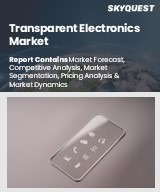
투명 일렉트로닉스 세계 시장 규모는 2023년에 19억 달러로 평가되었으며, 2024년 22억 9,000만 달러에서 2032년에는 101억 8,000만 달러로 성장하여 예측 기간(2025-2032년) 동안 CAGR 20.5%로 성장할 전망입니다.
투명 일렉트로닉스 시장은 가전, 자동차, 빌딩 자동화, 헬스케어 등 다양한 분야에서 가볍고 심미적으로 매력적인 디바이스에 대한 수요에 힘입어 크게 성장하고 있습니다. 재료과학의 발전과 인공지능(AI)의 통합은 스마트 윈도우, 헤드업 디스플레이(HUD)와 같은 고성능 솔루션의 개발을 촉진하고 있습니다. 스타트업과 기존 기업의 협업은 제조 및 유통 역량을 강화하고, 합작투자는 리스크를 줄여 지속가능한 성장을 촉진합니다. 그러나 첨단 소재와 관련된 높은 제조비용은 가격 경쟁력을 제한하고, 프리미엄 소비자에 대한 시장 접근을 제한하며, 전체 시장으로의 침투를 방해하고 있습니다. 그럼에도 불구하고, ADAS(첨단 운전자 보조 시스템)의 필요성에 힘입어 자동차 HUD 및 AR 대시보드에 투명 일렉트로닉스를 채택하여 사용자의 안전과 경험을 향상시키고 있으며, AI는 재료 탐색을 최적화하고 혁신적인 응용을 촉진하여 이 분야의 미래가 유망하다는 것을 보여주고 있습니다. 유망한 미래가 있음을 보여줍니다.
Global Transparent Electronics Market size was valued at USD 1.9 billion in 2023 and is poised to grow from USD 2.29 billion in 2024 to USD 10.18 billion by 2032, growing at a CAGR of 20.5% during the forecast period (2025-2032).
The transparent electronics market is experiencing significant growth, fueled by the demand for lightweight, aesthetically appealing devices across sectors like consumer electronics, automotive, building automation, and healthcare. Advancements in materials science and the integration of artificial intelligence (AI) are propelling the development of high-performance solutions, such as smart windows and heads-up displays (HUDs). Collaborations between startups and established firms enhance manufacturing and distribution capabilities, while joint ventures mitigate risks and promote sustainable growth. However, high production costs linked to advanced materials restrict affordability, limiting market access to premium consumers and hindering overall market penetration. Nevertheless, the adoption of transparent electronics in automotive HUDs and AR dashboards, driven by the need for Advanced Driver Assistance Systems (ADAS), continues to enhance user safety and experience. AI is optimizing material discovery and driving innovative applications, indicating a promising future for this sector.
Top-down and bottom-up approaches were used to estimate and validate the size of the Global Transparent Electronics market and to estimate the size of various other dependent submarkets. The research methodology used to estimate the market size includes the following details: The key players in the market were identified through secondary research, and their market shares in the respective regions were determined through primary and secondary research. This entire procedure includes the study of the annual and financial reports of the top market players and extensive interviews for key insights from industry leaders such as CEOs, VPs, directors, and marketing executives. All percentage shares split, and breakdowns were determined using secondary sources and verified through Primary sources. All possible parameters that affect the markets covered in this research study have been accounted for, viewed in extensive detail, verified through primary research, and analyzed to get the final quantitative and qualitative data.
Global Transparent Electronics Market Segments Analysis
Global Transparent Electronics Market is segmented by Material, Device Type, Form Factor, Application and region. Based on Material, the market is segmented into Metal Oxides, Conductive Polymers, Carbon Nanotubes, Graphene and Transparent Conducting Oxides. Based on Device Type, the market is segmented into Transistors, Diodes, Capacitors, Inductors and Memristors. Based on Form Factor, the market is segmented into Thin Films, Nanowires, Nanoparticles, Transparent Substrates and Hybrid Structures. Based on Application, the market is segmented into Displays, Lighting, Sensors, Solar Cells and Smart Windows. Based on region, the market is segmented into North America, Europe, Asia Pacific, Latin America and Middle East & Africa.
Driver of the Global Transparent Electronics Market
The global Transparent Electronics market is significantly driven by the rapid integration of artificial intelligence, which is emerging as a vital facilitator in this sector. AI's capabilities in real-time data processing, adaptive display management, and context-aware features greatly enhance the interactivity and responsiveness of transparent devices. As we move into 2024, the combination of AI with transparent displays in augmented reality headsets, smart windows, and in-vehicle infotainment systems is paving the way for new levels of usability and personalization. This trend is particularly impactful in consumer electronics and automotive applications, ultimately broadening the market's potential and appeal.
Restraints in the Global Transparent Electronics Market
The Global Transparent Electronics market faces significant constraints due to the high costs associated with the materials used, such as Indium Tin Oxide (ITO), graphene, and zinc oxide. Although advancements in AI-driven material discovery have expedited the processes of synthesis and testing, the commercial viability and scalability of alternative transparent conductors are still restricted. This limitation poses a challenge for mass production and prevents wider adoption in industries where cost sensitivity is a critical factor. As a result, these economic barriers hinder progress in the transparent electronics sector and may slow down innovation and market growth.
Market Trends of the Global Transparent Electronics Market
The Global Transparent Electronics market is witnessing a significant trend towards integrating AI-powered smart glass and transparent interfaces across various sectors. By 2024, the convergence of AI with smart window technology is revolutionizing how buildings, vehicles, and consumer appliances interact with their environments. These innovative smart windows, equipped with embedded transparent sensors, responsively adjust to lighting conditions, enhance privacy, and optimize energy efficiency. AI algorithms interpret ambient data and user behaviors to autonomously manage transparency and tinting, thereby driving a new wave of intelligent design and sustainable infrastructure, ultimately setting a precedent for future eco-friendly and adaptive architectural solutions.